Een nieuwe woonplaats, dus ook het genot van nieuwe cultuur en kunst! Een eerste indruk van de expositie door de Voorschotense Kunstkring in het Ambachts- en Baljuwhuis.

Een nieuwe woonplaats, dus ook het genot van nieuwe cultuur en kunst! Een eerste indruk van de expositie door de Voorschotense Kunstkring in het Ambachts- en Baljuwhuis.
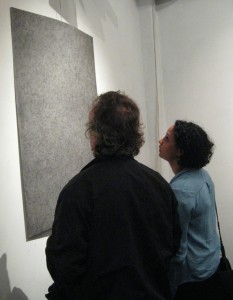
Brekend met haar gewoonte om in totale stilte te werken, liet kunstenares Faranú zich voor haar nieuwe werk inspireren door het soundscape-genre; een stijl van elektronische muziek, waarin het oproepen van een dromerige en soms onheilspellende sfeer centraal staat. Het resulteerde in ruim twintig houtskooltekeningen, waarvan een selectie sinds zaterdag 1 december wordt geëxposeerd in de Rotterdamse Galerie Kralingen.
Recensie voor Amigoe, 2012
Out with a Bang – de afsluitende borrel voor de expositie met nieuw werk van kunstenaar Everard Warffemius bij VERF Verweij & Frames, Bink36 in Den Haag
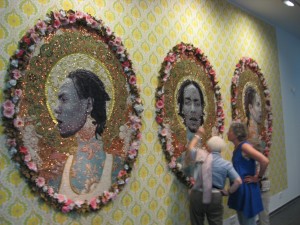
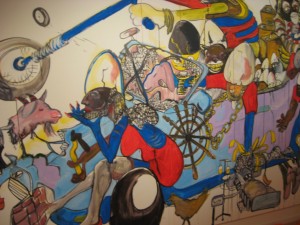
Het geldt voor de vijf of eigenlijk zes eilanden van de voormalige Nederlandse Antillen, maar het is ook zeker van toepassing op alle eilanden in het Caribisch Gebied; zoveel overeenkomsten als er tussen de samenlevingen zijn, zoveel verschillen zijn er ook. Hetzelfde geldt voor de relatie tot de voormalige kolonisator en voor de band met Afrika. Het zijn de ingrediënten voor de Caribische identiteit en cultuur en ze worden met kracht verbeeld in de expositie Who More Sci Fi Than Us, die werd geopend in de Amersfoortse kunsthal Kade.
Recensie voor de Curaçaose krant Amigoe.
Curaçao staat op het punt van een culturele aanwinst zonder gelijke. Een educatief kunstwerk, dat aandacht voor de natuur en geschiedenis combineert met een artistieke visie op een wereld waarin ondanks geweld en armoede ook altijd ruimte is voor hoop. Dat kunstwerk is de Kathedraal van Doornen, een creatie met de omvang van een huis, gerealiseerd door kunstenaar Herman van Bergen. 2 Sides Media schrijft op dit moment een subsidie aanvraag voor dit project.
Mon Art Gallery krijgt een nieuwe website. Gebaseerd op de ervaring als beheerder en tekstschrijver voor de huidige website, geeft 2 Sides Media advies over de pagina’s die nodig zijn, vrijblijvende tips over de indeling en levert uiteraard ook nu weer de teksten.
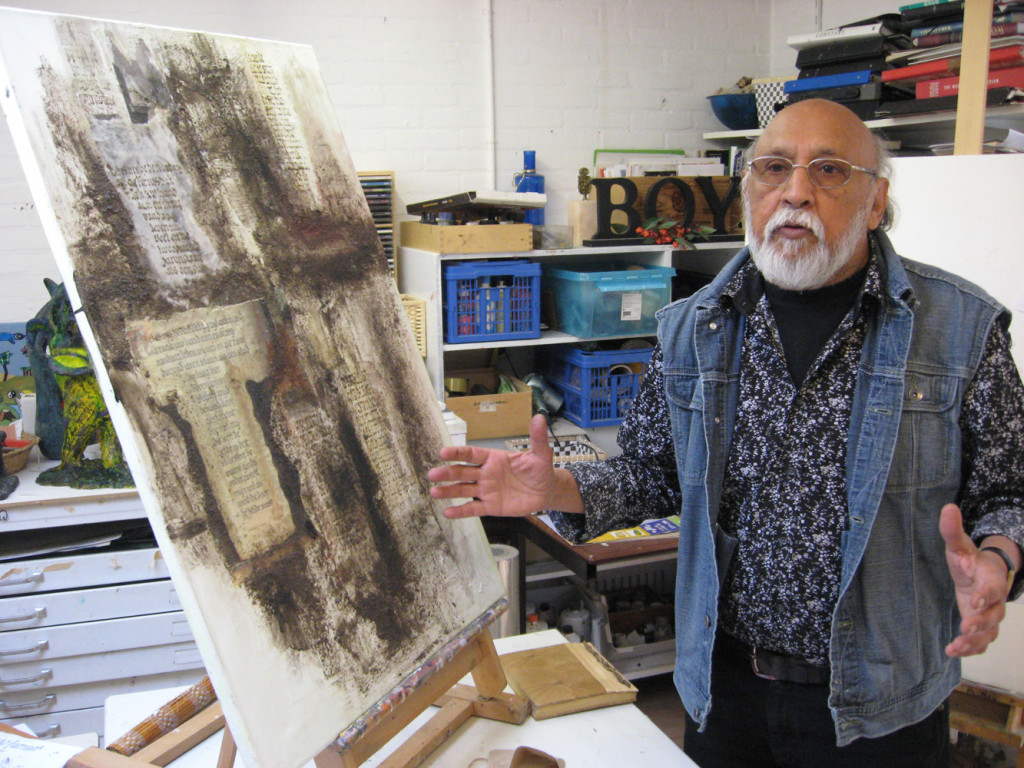
Als kunstenaar Boy Namias de Crasto over zijn jeugd vertelt, vervangt hij alle punten en komma’s in zijn zinnen door de woorden ‘want’ of ‘maar’ en staat hij voortdurend om zijn verhaal kracht bij te zetten. Zijn vrouw Pop voelt zich genoodzaakt om na een half uur, waarin hij onafgebroken aan het woord is geweest, een pauze in te lassen. “Als hij eenmaal vertelt, komt hij niet meer stil,” verduidelijkt ze.
Even later gaat haar man onverstoord verder. Op het ene moment staat hij bij de boekenkast in het atelier bij zijn woonhuis in Bussum, dan staat hij bij een van de schildersezels en opeens is hij naar buiten verdwenen om te wijzen op de bloemen in zijn tuin.
Jack Nicholson
Zesenzeventig is Namias de Crasto, maar de kleine man met zijn witte haar, gebruinde gelaat en twinkelende ogen zou makkelijk voor vijftig door kunnen gaan. Hij geeft nog steeds les en exposeert het werk dat hij elke dag maakt in zijn atelier of zoals hij het noemt, zijn laboratorium. Deze zomer wordt zijn werk geëxposeerd in het Curaçaohuis en in het najaar in volgt een tentoonstelling in Gallery Alma Blou. Daarnaast heeft hij het druk met een schilderij voor de theatervoorstelling One Flew Over the Cuckoo’s Nest, een verhaal over een psychiatrische inrichting dat vooral bekend is door de verfilming met acteur Jack Nicholson.
Tegelijkertijd werkt hij aan drie schilderijen voor een tentoonstelling over het verleden, het heden en de toekomst van Bussum. De schilderijen over de toekomst maakt hij samen met een groep kinderen en het verleden bevat teksten van de Nederlandse dichter Frederic van Eeden. “Als ik een tekst lees, over vreugde, verdriet, liefde, dan gaan mijn handen als het ware trillen en begin ik. Het boeiende aan kalligrafie is het spel tussen de pen, de inkt en de beweging. Ik lees de tekst, ik lees hem nog een keer en nog een keer en dan ga ik schilderen. Ik combineer de emotie van de schrijver met mijn eigen emotie. Ik visualiseer de achtergrond. Uiteindelijk teken ik de letters erin.”
Fragment interview voor Ñapa, 2011
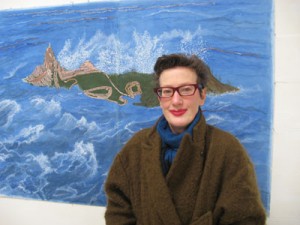
Onder een dreigende lucht vol grijze wolken, is de grond bezaaid met stenen, takken en omgevallen cactussen. Op de voorgrond ligt afval en aan de horizon staat het restant van een muur, omgeven door heuvels. Wie beter naar het schilderij kijkt, ziet dat er foto’s in zijn verwerkt en dat er in sommige takken woorden staan die betrekking hebben op de slavernij. Ooit stond hier landhuis Wechi.
Wechi is het laatste gebied dat de Nederlandse kunstenares Lydia Schouten bezocht na een verblijf op Curaçao. Drie maanden lang was ze met behulp van het Fonds voor de Beeldende Kunsten artist in residence bij Instituto Buena Bista (IBB), waar ze workshops gaf. Maar ze was ook druk bezig met haar eigen werk. Het resultaat is te zien in de tentoonstelling Transatlantische Dwaalgasten, die vandaag geopend wordt in de Amsterdamse Galerie Witteveen.
Interview Amigoe, 2010
By Otti Thomas
MAASTRICHT, Netherlands, Oct 18 (Reuters) – “Where are the crates. Don’t tell me they didn’t deliver them or I’m going to kill somebody,” shouts Malcolm McLaren to no one in particular. The designer of “anti fashion” and former manager of notorious seventies punk band the Sex Pistols sighs. McLaren doesn’t feel like talking because he has to finish an exhibition about himself as a work of art within 24 hours.
“This will take another two weeks,” he mutters and then asks his assistant for the Sid Vicious doll. Cursing and swearing he squats on the floor of Maastricht’s Bonnefanten Museum and puts the doll beneath a pile of bricks in a coffin containing relics of the punk era: boots, T-shirts and newspaper headlines announcing: “Sid Vicious is dead”.
Three hours later, during a tea break, 53-year old McLaren says that after fighting the establishment for more than 30 years, he accepts there’s no underground culture anymore.
“Life has become karaoke. Anyone can be a star for 15 minutes. You get up, you sing George Michael, you are George Michael. Everything is mainstream,” he says.
Four one-armed-bandits represent the karaoke element of life in McLaren’s new art project called “Casino of Authentici and Karaoke.” After opening in Maastricht, the exhibition is due to go to Germany, Britain, Japan and France.
By scoring three anarchy symbols on the slot machine, the player “wins” a video fragment about McLaren’s life, projected onto a screen.
“You can play with my life, without taking any responsibility for it. That’s karaoke,” he says. Relics from the past represent the authentic or romantic in life; alongside mementos from the punk era are some of the clothes McLaren designed with his former partner Vivienne Westwood, displayed pressed between glass sheets.
McLaren’s karaoke world is a world without any particular point of view. It differs from the past, when it was possible to live life without fitting into the norm.
“I expected people to live…for adventure. When I designed fashion, I wanted people to wear it as anti-fashion, to be the assassins of fashion. It was for people outside the establishment, with a different kind of behaviour, which maybe was symbolised in the way they wore their clothes,” he says.
He took some of his inspiration from Apache Indian culture and pirates, people who went their own way.
“Pirates would beat the living daylights out of a colonel who was colonizing an island for spices on behalf of the British empire – and then take his uniform. That’s a funky kind of pirate,” McLaren said.
In much the same way the Sex Pistols era, with its chaos and adventure, was funky, he says. “Philosophically speaking, it’s very romantic to become an outlaw at age 14, leave school, wear your blazer inside out, write ‘chaos’ on your armband, steal your mother’s safety pins and walk out into the streets. Live life to the full.”
But at the end of the century pop culture hasn’t got the power it once had, the fashion designer says.
“The new form of dressing, more often than not, is some kind of disguise to look like nothing. You can walk through every country and not worry about passport control. We don’t dress up like peacocks anymore and get out on the street to confront everybody at the bus stop. We are immune, used to that.” Since the karaoke world is democratic, he says it’s fine.
“It’s the way we’ve all decided culture should be. I’ve come to a point, where I’m trying to understand how the whole culture works and how I can work in it. I’m still a student,” he says.
The current exhibition is a first attempt to find his place in the karaoke world, he says.
“That’s what an artist does, tries to find a position in the world. The life of an artist is whatever he paints or creates. You try to take the past and ram it right into the future. That’s when you change the culture and you move on.”
McLaren is part of the Bonnefanten Museum’s exhibition on “Taste” which runs to February 13, 2000.
Interview for Reuters with Malcolm McLaren, 1999